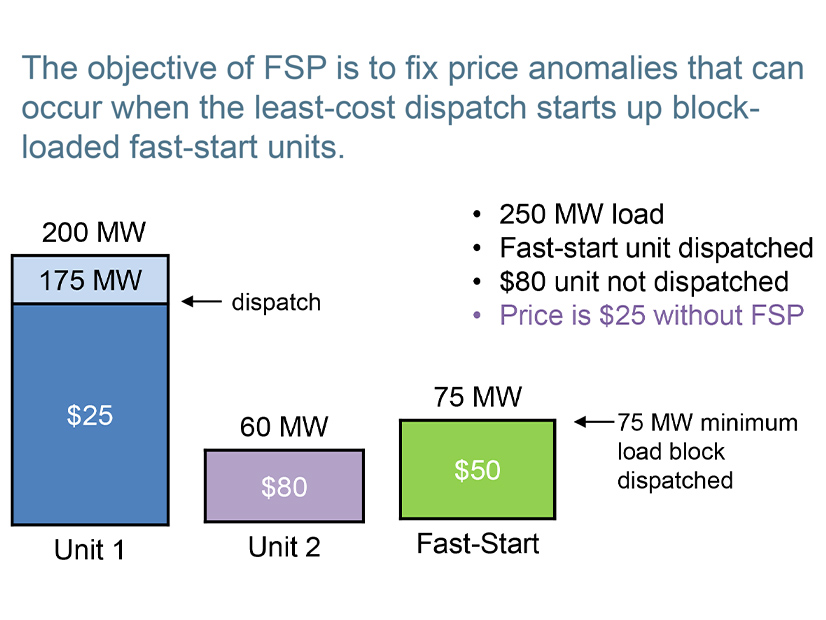
Fast-start pricing could fix certain “price anomalies” in CAISO markets more effectively than existing mechanisms for compensating ramping resources, the WEIM Governing Body’s market expert told the group.
Fast-start pricing could fix certain “price anomalies” in CAISO markets more effectively than existing mechanisms for compensating ramping resources, the Western Energy Imbalance Market Governing Body’s market expert told the group.
“The primary objective of fast-start pricing is to provide a more efficient price signal when fast-start units are dispatched to meet load,” Susan Pope, an electric power consultant appointed to assist the WEIM body, said during the group’s March 19 monthly meeting.
“The more accurate fast-start pricing signal cannot always and will not always be provided by either the flexible ramping product or shortage pricing,” Pope said.
Out of the six FERC-jurisdictional organized markets, CAISO alone doesn’t use fast-start pricing, a mechanism that factors the cost of starting and operating gas-fired peaking units into the wholesale market price.
According to a June 2022 analysis published by Powerex and the Portland, Ore.-based Public Power Council (PPC), CAISO and its Department of Market Monitoring (DMM) have actively opposed fast-start pricing and instead chose to rely on out-of-market payments to individual units to enable them to break even on daily variable costs.
But absent fast-start pricing, market prices may not reflect the cost of meeting incremental load when starting and operating natural gas units to meet peak demand, undermining the accuracy of pricing in the WEIM — and, paradoxically, causing participants to potentially pay more than necessary in some intervals.
“The understated price could incorrectly encourage parties to schedule additional exports, even though the price for meeting the export schedule in the dispatch could turn out to be higher than the understated price they actually end up paying,” Pope said. “The flip side of this is that the price signal for incremental supply is also understated, which sends the wrong signal to encourage incremental supply to offer the dispatch.”
Pope also pointed out the 2022 report may have substantially overstated the potential price impact of fast-start pricing due to a lack of nonpublic data CAISO since has gained access to.
In December, CAISO presented its own analysis of fast-start pricing and sought stakeholder feedback for developing its scope.
Flexible Ramping and Shortage Pricing
Other pricing mechanisms, such as the flexible ramping product and shortage pricing, won’t fix the fast-start pricing issue, Pope said, because while they can overlap and trigger simultaneously, they operate under different grid conditions and provide distinct functions.
“The underlying reason why the flexible ramping product and shortage pricing will not fix the fast-start pricing anomaly is at root because the three pricing enhancements are aimed at fixing different things,” Pope said. For example, fast-start units could be dispatched to meet load when there is neither a flexible ramping constraint nor a capacity shortage, meaning that neither of the alternatives can be relied upon to substitute fast-start pricing.
Impact on the WEIM
The use of fast-start resources to meet incremental load would increase locational marginal prices and potentially reduce emissions, Pope said.
“One of the possible benefits of fast-start pricing is to enable others who are not required to bid or offer into the market to see the higher price and choose to participate, and by their participation, offer the opportunity to displace the start-up of more costly emitting units,” she said. The higher prices also could improve market efficiency by increasing the number of bids and offers, she added.
The potential environmental impact of not using fast-start pricing was a key concern outlined in the 2022 analysis, which identified that lack of the price signal could weaken carbon-pricing programs.
“The calculation of wholesale market prices in CAISO-operated markets not only excludes the cost of starting and operating natural gas peaking units, it also excludes the cost of GHG emissions from those units, which can be among the highest in the grid,” the report reads. “This undermines a key goal of carbon-pricing programs, including California’s cap-and-trade program as well as programs being explored by multiple other Western states.”
Fast-start Pricing in Other Markets
Examining the efficiency of fast-start pricing in other RTOs and ISOs can offer CAISO insight into how the mechanism could operate in its markets, Pope said.
Fast-start pricing has been a feature of NYISO since 1990 and MISO since 2010, and independent market monitors are divided on their views on the mechanism.
According to Potomac Economics, the IMM for NYISO, MISO and ERCOT, fast-start pricing has “significantly improved real-time price formation in MISO” and “has led market price signals to better reflect system conditions and provide better performance incentives for flexible resources when fast-start units are deployed” in NYISO.
PJM IMM Monitoring Analytics takes a dimmer view, finding that fast-start pricing distorts “the correct signal for efficient behavior” and inappropriately pays higher prices to inflexible generators.
And in 2023, CAISO’s DMM said fast-start pricing “is inconsistent with the features of locational marginal pricing that maximize market surplus and provide incentives for units to operate at the most efficient, socially optimal dispatch level.”
It’s unclear whether an existing fast-start pricing design could be added easily to the WEIM of the ISO’s Extended Day-Ahead Market. Even if the mechanism is effective in other regions, Pope said, market changes would be needed to reflect the scheduling and pricing modeling runs used for WEIM dispatch, which CAISO still is studying.
Regardless of the challenges, WEIM Governing Body members appeared open to considering fast-start pricing.
“It is a subject of great interest and much debate, and I think we could all use a greater understanding of this and how it applies in the current West,” said WEIM Governing Body member Robert Kondziolka.

